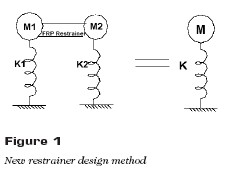This project evaluated the use of fiber-reinforced plastic (FRP) fabrics as restrainers in the seismic rehabilitation of highway bridges as an alternative to steel for restrainer construction to reduce bridge hinge movement during earthquakes. Glass, carbon, and glass/carbon hybrid restrainers were constructed and evaluated in large-scale dynamic laboratory tests. The research effort included (i) tensile tests on FRP strips and on FRP/concrete bond at various loading rates, (ii) FRP restrainer development and dynamic testing, (iii) shake table tests, data analysis, and performance comparison for FRP, steel, and SMA restrainers, and (iv) development of a FRP restrainer design method.
The results showed that the FRP strength was insensitive to strain rate and that the FRP/concrete bond was a function of concrete shear strength but insensitive to strain rate. The results also demonstrated methods for flexible restrainer construction and restrainer/concrete bonding. A simplified FRP restrainer design method, considered more realistic than that of AASHTO was proposed (Figure 1) that takes into account the dynamic characteristics of a bridge structure. The final report is available from the National Technical Information Service (NTIS # PB2007-100047).

The final report for this IDEA project can be found at:
https://onlinepubs.trb.org/onlinepubs/archive/studies/idea/finalreports/highway/NCHRP97_Final_Report.pdf.